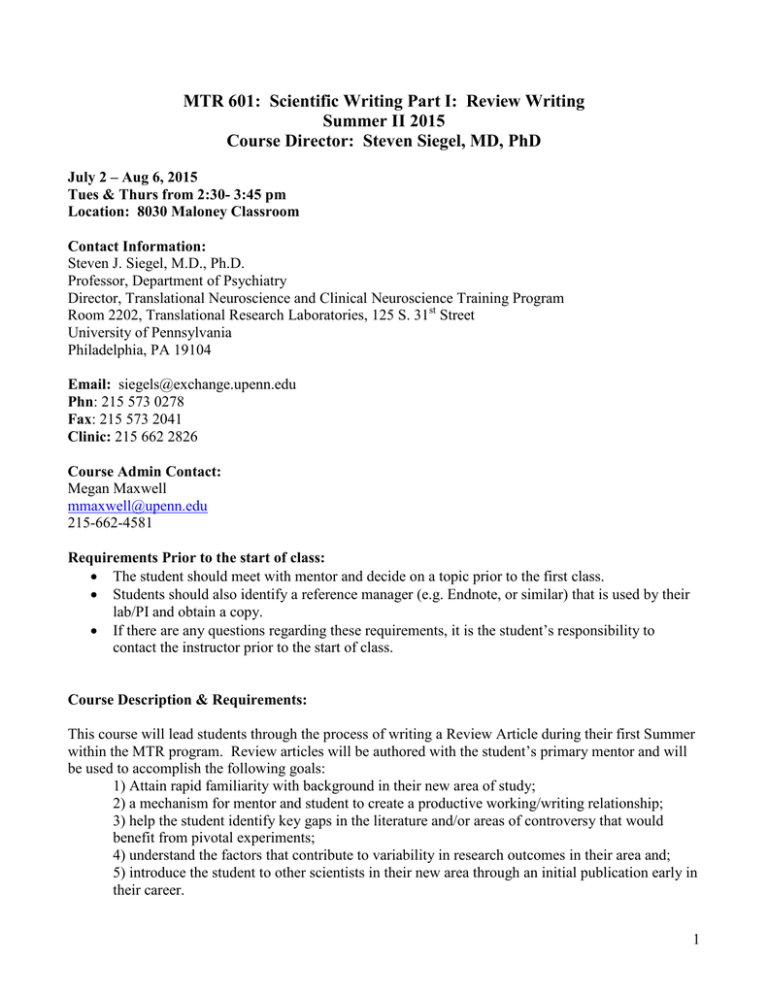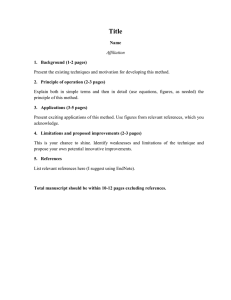Steps to Publishing a Journal Article
advertisement

MTR 601: Scientific Writing Part I: Review Writing Summer II 2015 Course Director: Steven Siegel, MD, PhD July 2 – Aug 6, 2015 Tues & Thurs from 2:30- 3:45 pm Location: 8030 Maloney Classroom Contact Information: Steven J. Siegel, M.D., Ph.D. Professor, Department of Psychiatry Director, Translational Neuroscience and Clinical Neuroscience Training Program Room 2202, Translational Research Laboratories, 125 S. 31st Street University of Pennsylvania Philadelphia, PA 19104 Email: siegels@exchange.upenn.edu Phn: 215 573 0278 Fax: 215 573 2041 Clinic: 215 662 2826 Course Admin Contact: Megan Maxwell mmaxwell@upenn.edu 215-662-4581 Requirements Prior to the start of class: • The student should meet with mentor and decide on a topic prior to the first class. • Students should also identify a reference manager (e.g. Endnote, or similar) that is used by their lab/PI and obtain a copy. • If there are any questions regarding these requirements, it is the student’s responsibility to contact the instructor prior to the start of class. Course Description & Requirements: This course will lead students through the process of writing a Review Article during their first Summer within the MTR program. Review articles will be authored with the student’s primary mentor and will be used to accomplish the following goals: 1) Attain rapid familiarity with background in their new area of study; 2) a mechanism for mentor and student to create a productive working/writing relationship; 3) help the student identify key gaps in the literature and/or areas of controversy that would benefit from pivotal experiments; 4) understand the factors that contribute to variability in research outcomes in their area and; 5) introduce the student to other scientists in their new area through an initial publication early in their career. 1 Mentors agree to participate in this process when signing the MTR Mentor Compact, or identify another senior individual in their group who would perform the function as a condition to have MTR students funded in their program. The course director and members of the curriculum committee will provide guidance and critical reviews throughout the process. Role of Mentor in the course - Agreement from MTR Mentor Compact: o Summer of MTR year 1, Review Manuscript: I will meet with my mentee weekly during the first summer of the program to guide in authoring a review manuscript in their proposed area of study for publication. This will help the student to learn the appropriate background in order to design and execute appropriate studies over the following two years. My responsibilities will include guiding the mentee regarding both content and structure of the article, as well as teaching them how to identify a suitable journal and submit the finished manuscript for publication. Completion of the course, and continuation of associated funding in my laboratory is contingent on submission of the manuscript. Attendance: Students are expected to attend all classes. If for any reason a student will not be in class, they should contact the instructor and MTR admin prior to class to alert them of the absence and make arrangements to make up course content. Grading: Students will be graded based on class attendance, participation, and submission of a final review article. 30% – Class Participation & Attendance 70% – Final Review Article Academic Policies: For information on academic policies please refer to the MTR Student Handbook on the web: http://www.itmat.upenn.edu/ctsa/mtr/ 2 Course Timeline: Below you will find an outline of basic course topics sourced from the document Steps to Publishing a Journal Article by Karen. I. Winey. All meetings @ 2:30 – 3:45 pm in 8030 Maloney 1. Thursday July 2: Introduction to the class a. Timeline – 5 weeks b. Define scope and data c. How to interact with PI d. Outline e. Referencing 2. Tuesday July 7 and Thursday July 9: a. Initial outline complete b. Set up database c. Refine scope d. Choose journal and contact editors (refine scope) e. Author list and assignments f. Review challenges of the past and coming week 3. Tuesday July 14 and Thursday July 16: a. Mock up Figures b. Refine outline (keep it focused) c. Expand data base (carefully) d. Filling in details (body text level) e. Review challenges of the past and coming week 4. Tuesday July 21 and Thursday July 23: a. Finalize outline (i.e. set scope) b. Data lock (raise the bar to add more) c. Making figures and tables (organize the data) d. Finalize in body text throughout e. Focus on main conclusions f. Review challenges of the past and coming week 5. Tuesday July 28 and Thursday July 30 a. Final Draft b. Add abstract c. Draft cover letter to journal d. Choose reviewers e. Review challenges of the past and coming week f. Deliverables: Send a draft when done, update when submitted and accepted g. Provide feedback to help improve the course 6. Tuesday August 4 and Thursday August 6 3 Steps to Publishing a Journal Article Karen I.Winey, March 2003 Compiling Data: In this stage of the process all pertinent data is gathered and organized into figures. Gather all pertinent data; do not omit any data at this point Develop a notation scheme for samples Create various figures and tables that include all the data. Draft figure captions to provide all the pertinent information regarding the experiment Develop Conclusions: After the data is compiled, select the primary and secondary conclusions for the journal article within the context of the field. Identify the 10-15 most pertinent papers in the field Compile the primary and secondary conclusions of these papers Summarize these publications with respect to similarities and differences with our data Replot, reconfigure and/or reanalyze compiled data for easier comparison, as necessary Write a brief paragraph for all possible conclusions Consider additional experiments to strengthen these conclusions Select and refine primary (1-5) and secondary (1-5) conclusions Select journal for submission Select type of publication (note, article, communication) Write the title Select coauthors Enter paper on your resume and in Endnote as "in preparation" Write Journal Article: Prepare a document for submission to the selected journal. Review requirements of the selected journal (format, page limits, bibliography format); this information is often available on-line or in the first issue of the year Outline paper keeping the primary/secondary conclusions in mind More detail in the outline makes writing easier Develop a logical sequence of information and arguments in the paper Select and revise figures and tables for journal article Select divisions of paper (i.e. introduction, experimental methods, etc.) Decide where to introduce major references Decide where to insert figures (this will set the sequence of figures) Review outline for consistency in terms Prepare to write Ensure that the bibliographic index (Endnote) is complete Revise sample notation to better support conclusions Revise figure captions to better support conclusions; note that figure captions are usually separated from figures in the manuscript Select when and where you will write Write the first draft according to the outline If all the steps above have been thoughtfully done writing will be quick and fun Begin by writing the easiest, clearest section 4 Rather than stopping a writing session at the end of section, try to write the first paragraph of the next section Write quickly, knowing that you can and will edit later; you can even add the references later Start with the familiar/simple and add layers of complexity as the paper progresses Remember to state the obvious, without repeating the trivial Use numerical data to support your points Similarly, avoid vague words such as "very" and "higher" – be specific Prepare draft for distribution: include title, authors and authors' affiliations, targeted journal, figure captions, figures and references; format references; check spelling and grammar Give the first draft to at least one coauthor Receive feedback about the first draft Incorporate feedback from coauthor into second draft Write the abstract; note the guidelines of the targeted journal Revise the title, as necessary Give the second draft to at least one coauthor Receive feedback about the second draft Incorporate feedback from coauthors in the next draft Repeat revise/give/receive feedback steps until all coauthors are satisfied. Submission and Review Journal Article: After the document is prepared, it is submitted to the journal for peer review. Review the submission procedures for that specific journal (on-line or on paper); this information is often available on-line or in the first issue of the year Select 1-4 suggested reviewers Select contact author Follow instructions for submission, which might include a cover letter from the contact author (see example A), a copyright form provided by journal, etc. Record date and mode of submission Inform coauthors of submission Enter paper on your resume and in Endnote as "submitted" Record confirmation of receipt including the assigned editor and manuscript number – usually with 7 days, otherwise contact journal. Expect reviews with in a 6 weeks, otherwise contact editor Distribute reviews (1-3) to all coauthors Reread the manuscript, while considering the reviewer comments Draft response to reviewer comments, typically this is done in an itemized list (see example B). Revise manuscript and figures, as necessary Distribute draft response to reviewers with all coauthors Receive input from coauthors Finalize response to reviewer comments Finalize manuscript and figures 5 Follow instructions for sending the response to reviewer comments to the editor and for resubmitting the paper, which might include sending a disk, completing a form, etc. Record date resubmission Inform coauthors of resubmission Enter paper on your resume and in Endnote as "resubmitted" Expect acceptance within 2 weeks, unless editor contacts the reviewers again Inform coauthors of acceptance Enter paper on your resume and in Endnote as "accepted" Publication of Journal Article: After a paper is accepted the manuscript is forwarded to a production team at the publisher during which time the manuscript is prepared for printing. Expect page proofs from publisher Distribute copies of page proofs to all coauthors, set the original page proof aside Carefully read every word of the formatted article including title, authors and affiliations, figure cations, etc. noting corrections in colored pencil Update bibliography where applicable; for example, change "submitted" to "accepted" Respond to specific inquiries from the production team Carefully inspect figures for reproduction quality Compile corrections from all coauthors onto a single copy of the page proofs, reconciling any differences Send the corrected page proofs and any additional information to the production team as instructed; clearly indicate whether or not you want to see the page proofs again before publication Decide how many reprints to order and forward request to Towne business office Decide how to pay for page charges and forward request to Towne business office Enter paper on your resume and in Endnote as "in press" Await publication date Inform coauthors of publication, including the complete reference Enter paper on your resume and in Endnote with complete reference Await delivery of reprints Distribute reprints to coauthors Distribute reprints to interested colleagues Provide feedback to Karen (& coauthors) about the process 6 7


